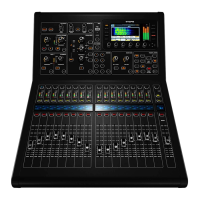27 DIGITAL RACK MIXER M32R User Manual
main
The main tab displays and controls all aspects of the main bus assignments.
The main tab contains the following parameters that can be adjusted using
the six push encoders:
1. Adjust the rst push encoder to pan the selected channel within the
main stereo output.
2. Tap the rst encoder to assign the selected channel to the
main stereo output.
3. Turn the second encoder to adjust the level of the currently selected
channel within the mono (centre) bus.
4. Tap the second encoder to assign the selected channel to the mono
output signal path. Use this function when crafting an LCR mix, as
opposed to a mono or stereo mix.
5. Tap the fth encoder to solo/unsolo the currently selected channel.
6. Adjust the sixth encoder to set the fader level for the currently
selected channel.
7. Tap the sixth encoder to mute/unmute the currently selected channel.
2.2 Meters
The METERS screen displays dierent groups of level meters for various signal
paths on the console, and is useful for quickly ascertaining if any channels
need level adjustment. Since there are no parameters to adjust for the
metering displays, none of the metering screens (with the exception of the
rta tab; see below) contain any ‘bottom-of-screen’ controls that would normally
by adjusted by the six push encoders.
The METERS screen contains the following separate screen tabs, each containing
level meters for the following signal paths:
channel
• Level meters and fader levels for the 32 input channels.
mix bus
• Level meters, fader levels and gain reduction meters for the 16 bus masters
• Level meters, fader levels and gain reduction meters for the six
matrix outputs
• Level meters, fader levels and gain reduction meters for the stereo main bus
and the mono bus.
aux/fx
• Level meters for the six auxiliary sends
• Level meters and fader levels for the eight auxiliary returns
• Level meters and fader levels for the four stereo eects returns.
in/out
The 32 input channels
The eight auxiliary returns
• The six auxiliary sends
• The two rear panel digital outputs
• Monitor outputs
• The 16 rear panel analogue outputs
• The P16 ULTRANET outputs.
rta
The rta tab shows details of the M32’s Real Time Analyser - a real-time
spectrum analyser that displays details of the audio signal on the selected
signal path. The M32 features both bar graph and spectrograph with a
10-second window, that are displayed on the Main Display, and can be used in a
variety of applications. The frequency resolution of both analysers is 100 bands,
with constant relative bandwidth from 20 Hz to 20 kHz. Hence they are three
times more detailed than typical third-of-an-octave RTAs. Both graphs can be
visualised in a separate Meter screen, on top of each channel parametric EQ and
on the FX rack graphic EQ screens.
RTA Source
Depending on the application the analyser input signal can be taken from the
selected channel itself, any other pre-dened channel or dynamically depending
on monitor source signals (i.e. Main/Solo). When EQ-ing a main PA system
for example, the Graphic EQ may be inserted in Main LR, while the analyser signal
may come from a dedicated measuring mic input channel. Select the source
signal using the sixth push encoder.
Solo Priority
When switched on, the selected RTA source signals will be replaced with the
monitor solo bus whenever a channel solo is active.
TIP: This option might be useful, if you wish to analyse a group of
channels concurrently, or if you have a xed signal on the RTA that needs to be
replaced only temporarily with some other channel’s signal.

